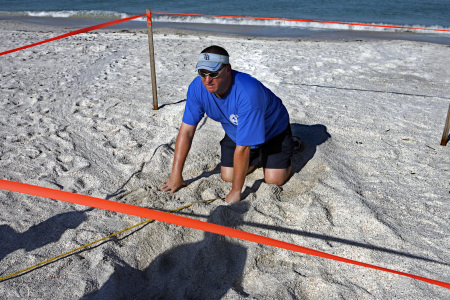Mike Anderson of the Clearwater Marine Aquarium measures the first loggerhead turtle nest of the year, at Sunset Beach in Treasure Island, on Sunday. A beachgoer saw a turtle digging and alerted authorities. The nest will be monitored until the hatchlings emerge.
[JIM DAMASKE | Times
May 25, 2010
By Sara Gregory, Times Staff Writer
With the oil spill casting a shadow of danger, turtles begin making nests. Wildlife officials are cautiously waiting to see what impact the Deepwater Horizon oil spill will have on sea turtles as their nesting season gets under way. Biologists worry about oil spill’s effects on nesting sea turtles.
The number of loggerhead turtle nests along Pinellas beaches has grown moderately the past two years, recovering from an all-time low in 2007. Officials were hoping the growth would have continued or stayed the same, though what will happen now is anyone’s guess.
“Probably strange things,” said David Godfrey, executive director of the Caribbean Conservation Corporation, an organization dedicated to advocating on behalf of sea turtles. “It’s really impossible to guess what this spill may do to the nesting season.”
The oil spill could affect turtles in a number of ways.
Oil in the gulf could leave adult turtles too ill to mate or make it to the beach to lay their eggs. If the oil reaches the shore, it could contaminate nests, cutting off oxygen to the eggs buried in the sand.
Hatchlings that make it back to the water could face even more challenges. They spend the first years of their life swimming in the loop current, which could become contaminated with oil. If that happens, oil could burn their skin and they could mistake tar balls for food.
“You can imagine this little mouth with this marble-sized tar ball in its mouth,” Godfrey said. “It’s not coming out.”
Pinellas County’s first loggerhead turtle nest of the season was discovered Sunday morning on Sunset Beach Treasure Island. That’s on track with when the first nests are usually found, said Mike Anderson, Clearwater Marine Aquarium’s supervisor of sea turtle nesting.
Nesting season began May 1 and continues until Oct. 31, though most of the golf ball-sized eggs will have been laid by the end of September, Anderson said.
Throughout that time, Anderson and his staff will patrol the beaches, looking for the telltale signs of turtle nesting: drag marks in the sand from flippers, a mound of sand near where the eggs are buried and more drag marks as the female turtles make their way back to the water.
Both Godfrey and Anderson stress that the spill’s full effects might not be known for decades, when the hatchlings born this season reach maturity.
“This spill keeps me up at night,” Godfrey said.
There were signs before the spill that the loggerhead population was struggling.
“We’ve really had an unusual last 10 years,” said Anne Meylan, a research administrator with the Fish and Wildlife Research Institute. About 55,000 nests were laid statewide each year in the late 1990s, a number that dropped about 43 percent by 2006.
Unprecedented cold weather in January left thousands of turtles in “cold stuns,” unable to move.
And in March, the U.S. Fish and Wildlife Service and the National Marine Fishery Service declared its intent to change the status of loggerhead turtles from “threatened” to “endangered.”
Florida’s other two turtle species, the leatherback and green turtles, already are listed as endangered. If the loggerhead turtle joins their ranks, it could mean extra efforts to identify and preserve crucial loggerhead turtle habitats.
For now, there’s only wait-and-see, Meylan said.
“Everybody’s just heartsick about it,” she said. “Turtles are dead center in this particular mess.”
Sara Gregory can be reached at (727) 893-8785 or sgregory@sptimes.com.
By the numbers
Loggerhead nests found in Pinellas by Clearwater Marine Aquarium
2005 105
2006 115
2007 38
2008 108
2009 138
